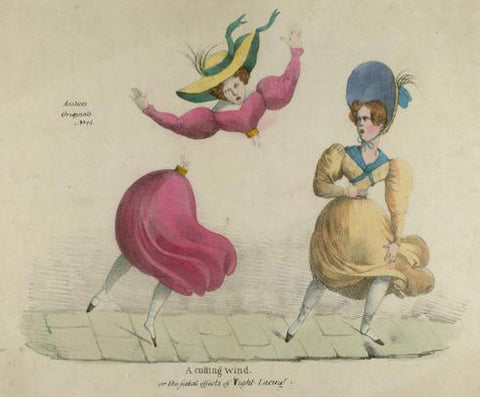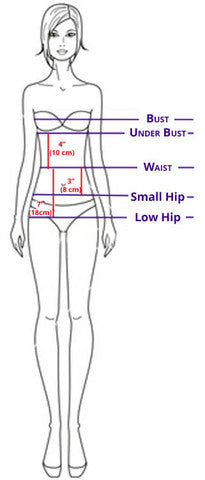Everything You Have Every Wondered About Corsets, Part 2
This is part 2 of a blog series where we are talking about everything you have every wondered about corsets.

In this post, we will be covering waist training, seasoning your corset, and health benefits of corset wear. We are also covering how to choose the right size, and finally, addressing the myths and rumors around corsets being dangerous. Take a look at Part 1 for more information and on other corset-related topics.
What is Waist Training?
Every day there is a new celebrity whose Instagram is filling up with waist training praise. Here are all the details.
Waist training is a process of wearing a steel boned corset to semi-permanently mold your waist into an hourglass figure. Considered a body modification technique, over a long period of time the continuous pressure and remolding, will leave you with a waist that retains an hourglass figure. Even when the corset is not worn. What it will not do, is make you lose weight. Sadly enough, you will still need the old-fashioned diet and exercise for that goal.
Waist training takes enormous dedication. When done properly it produces noticeable results. Many users swear they also experience other positive benefits.
How soon can you see results from waist training?
You know the old rule, hair grows a ½ inch per month? Unfortunately, there is no exact formula like this for training the waist. Results vary based on the individual's circumstances and other factors. Here is the breakdown.
Amount of body fat
The softer your waist and stomach area is, the amount in inches a corset may be able to" pull it in," or cinch, is significantly greater. But it will take longer for the fat to diffuse and remold itself to other areas of the waist.

If your stomach and waist area is mostly muscle there won't be a huge change seen in the circumference of the waist at first. But, the body will be quicker to retain the hourglass shape when not wearing a corset.
Other factors
A properly fitting corset is key. The piece should be flat against the body without bulges or bends. Consist wear of the trainer is required. Working up to wearing the piece 8 hours to then skip a week is not going to produce the same results as those who are consistent.
Seasoning your corset
Let's talk about seasoning. You may have heard the term on a blog or a corsetry shop and wondered what it meant. Seasoning your corset is a fancy way of saying; break it in. The same way you would not wear a new pair of stiff shoes for a prolonged period of time; your corset also needs time to adjust to the shape of your body.
Corsets are made to be pulled tightly, but they need to gradually be worn over a few wears before achieving a tight-lace. By working up to long periods of wear slowly, you have a better chance of the bones warping well with your curves. The fabric, stitching, and eyelets will remain undamaged when properly seasoned.
This advice is especially poignant for waist training corsets, which are crafted with steel bones, and firm material.
Do fashion corsets require seasoning?
Generally, fashion corsets are not intended for prolonged use. A waist training corset might be worn every day under your clothes vs a fashion corset worn for a single outfit. Fashion corsets often have fabric laces vs the firm cord laces of a waist training corset. You should still gradually allow the corset to get used to your body before fully tightening the laces, but you do not have to wait multiple wears.
Are corsets dangerous?
There is plenty of bad information to go around about the safety of corsets. In the Victorian Age, there were warnings about wearing a tightly laced corset. They ranged from moving the internal organs to a completely different place in the body to causing hysteria and even death.
As grotesque and terrifying these assumptions were, it teaches us 2 things;
- People in the Victorian Age did not understand how a corset worked.
- It was best not to get sick back then since it seems doctors didn't have much of an idea of how the human body in general worked. Scary stuff!
Note: This scene below; has never happened. I promise.
To answer the question; no. Corsets are not dangerous. With proper use and wear corsets are completely safe. They can help you achieve a cinched waist look or be used to train the waist.
The process of waist training is also safe and does not damage your body. In fact, a study done by orthopedic surgeons in Japan found that wearing a corset could actual help some of their chronic pain patients.
What are the benefits of waist training or corset wearing?
The obvious benefit of training your waist, or corset wearing, is being happy about the way you look when you have one on. When we feel confident, sexy, and proud of our silhouettes it's pretty awesome.

Corsets by nature also improve your posture while tightened around the body. There are certain medical conditions and ailments that are said to improve by wearing a corset. I can personally tell you from experience, if I wear one while I am sitting at the computer for an extended period of time, my back feels better than usual. While we totally want you to feel better if this is a problem you experience, you should definitely talk with the doctor first. Ask if a corset might help you out with pain before you go trying one out for solely this purpose.
Should I buy my corset in a smaller size than I regularly wear?
This is a common question. Customers wonder should they buy a size down than they would regularly wear? Since the end goal is achieving a waist that is smaller than an un-corseted size, I understand how this could be confusing.
No, you should not buy a corset that is too small. Let's talk about sizing.
The process of choosing a size for any garment, especially when purchasing online can seem daunting. Size charts are fantastic but confusing too. My own measurements put me in the medium category for bust, but my waist and hips are large. A full-figured woman with a large bust might have the opposite outcome, with her bust requiring a large and waist coming in at a small.
First decide, what type of corset you want.
The Overbust, the Bustier, and Corset dress
Overbust and bustier corsets cover the bust and can meet at the high or low waist. The long line option will come down over the lower hips (area where regular jeans would end) extending to cover about half of the hip area.
The easy solution; size for your bust. If you don't have enough room up there for the girls the corset will not be comfortable. The laces will be able to pull everything else, the hips and waist, together. In my case of a smaller bust, I don't want there to be a gap between my bust and the fabric so I would still order for my bust size.
The Underbust
An underbust corset starts at the hips and ends just below the bust. They can be worn under clothing to shape or for waist training. They can also be worn over clothing to achieve both cinching and fierce fashion.
Since the bust is not involved, for this piece you size for your waist.
How do I measure myself?
Tools required: Tape measure
When measuring the bust, you want to get the numbers from the fullest point. Think, the middle area where your bra cup holds you up. Measure yourself bra free.
Wrap the tape around your back and pull up to meet the area you will be measuring. Make sure you are standing up straight. Next continue the tape around your bust area. Pull taut, but not tight. What I mean here is you do not want any bulge around the tape – we want to see an accurate circumference. However many inches you get is your bust measurement.
Waist
The first step is finding your natural waist. Often this is the smallest part of your waist. You can check out our sizing chart below for guidance if you are unsure of where this is. A good test to confirm you have found your natural waist is standing in front of the mirror and bending side to side. The "bend," is the natural waist.
As with measuring the bust, you want the tape taut, but not tight. The tape should be flat against your body with no creasing. You do not want to hold in your stomach while measuring, but you do want to be standing straight.
If you are having trouble choosing the size for you, we are always available to help you out. Email support@atomicjaneclothing.com and a member of our team will help you pick.











Hey Melanie! You just gave me an idea for a future blog. Your goth club outfits sound fabulous. I really want you to breathe!! Have you been fitted? Maybe there is a different size or style that might keep you full of breath to dance the night away :)
Ali!! Lots of stuff to learn here, and yes, waist training has some interesting parts. Thanks for reading :)
I love corsets and often wear them clubbing. They are very fashionable at the goth clubs I go to. I just wish they didn’t make me feel like I can’t breathe. LOL! This is a really informative post. Thanks for the tips!
Wow I never knew there was so much to waist training!